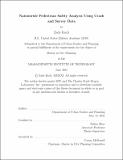| dc.contributor.advisor | Zhao, Jinhua | |
| dc.contributor.author | Koch, Zade | |
| dc.date.accessioned | 2022-01-14T14:46:01Z | |
| dc.date.available | 2022-01-14T14:46:01Z | |
| dc.date.issued | 2021-06 | |
| dc.date.submitted | 2021-07-27T20:27:20.409Z | |
| dc.identifier.uri | https://hdl.handle.net/1721.1/139036 | |
| dc.description.abstract | Pedestrian safety is studied using two approaches: injury severity modeling using NHTSA’s Crash Report Sampling System crash data and administering a nationwide survey on roadway safety topics. The crash data models identified seven significant independent variables which relate to severe pedestrian injuries: weather, lighting condition, speed limit, speeding violation, vehicle body type, driver impairment, and pedestrian age. When crashes at intersections and non-intersections were compared, the effects of these variables did not significantly vary. The nationwide survey concentrated on topics unavailable or incompletely described in the crash data, including pedestrian safety perceptions and four unsafe behaviors: intoxicated driving, cell phone use while driving, intoxicated walking, and cell phone use while walking. Public beliefs about dangerous pedestrian scenarios largely agreed with findings from the crash data. The Theory of Planned Behavior was applied to the unsafe behaviors, leading to distinct suggestions for public awareness messaging for each of the behaviors. | |
| dc.publisher | Massachusetts Institute of Technology | |
| dc.rights | In Copyright - Educational Use Permitted | |
| dc.rights | Copyright retained by author(s) | |
| dc.rights.uri | https://rightsstatements.org/page/InC-EDU/1.0/ | |
| dc.title | Nationwide Pedestrian Safety Analysis Using Crash
and Survey Data | |
| dc.type | Thesis | |
| dc.description.degree | M.C.P. | |
| dc.contributor.department | Massachusetts Institute of Technology. Department of Urban Studies and Planning | |
| mit.thesis.degree | Master | |
| thesis.degree.name | Master in City Planning | |
